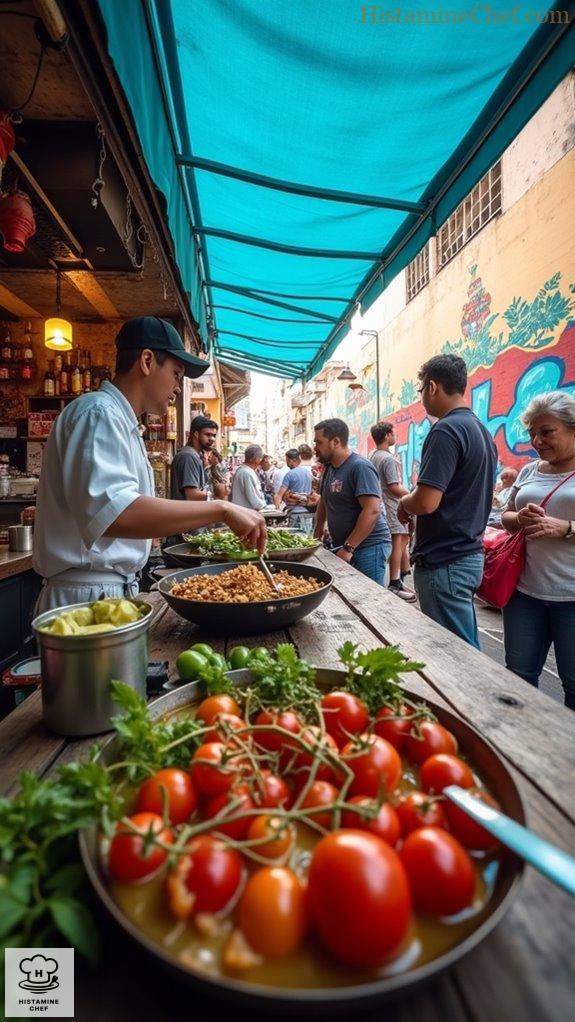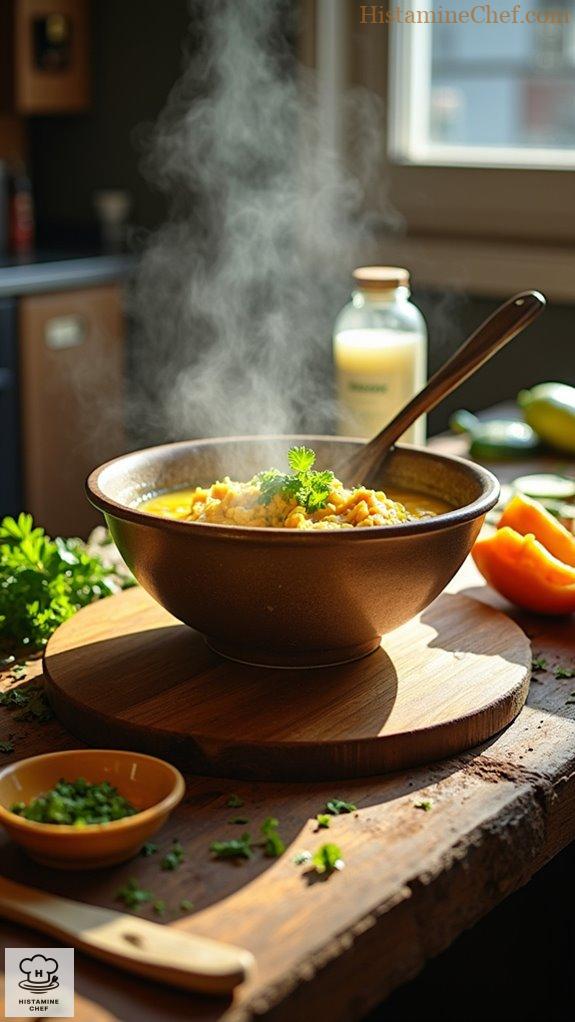If you think street-style chakalaka is off-limits for those avoiding histamines, think again! I whip up this spicy South African relish at home by ditching tomatoes and onions for sweet pureed pumpkin and fresh zucchini instead. Sauté with vibrant bell peppers and a dash of curry for that signature kick. Toss in herbs like parsley for freshness, and you’ve got a dish bursting with flavor. Curious how I bring it all together? Let’s explore the magic behind this vibrant recipe!
Vibrant Street Culture Hub

In the vibrant urban culture hubs, street food represents a rich tapestry of history and flavors, encapsulating the diverse culinary traditions of the city.
Street food culture traces its roots back centuries, originating as a means for vendors to offer affordable and accessible meals to the bustling masses. In many neighborhoods, food trucks and stalls serve as platforms for local chefs and home cooks to showcase their signature dishes, often reflecting the multiculturalism of the area. Additionally, just as street art serves as a platform for local artists to gain recognition, food vendors contribute significantly to their local cultural expression and community identity.
From spicy grilled meats to savory pastries, each dish tells a story of shared heritage and community identity. The lively atmosphere created by street food often fosters communal interaction, as residents and visitors gather to savor an array of exotic flavors while enjoying live music or art displays.
As street food continues to evolve, it remains integral to the ongoing narrative of urban cultural expression, contributing to the local economy and fostering a sense of pride and belonging among residents.
Through taste and tradition, vibrant street food culture enhances the dynamic character of urban hubs, ensuring they remain lively social spaces for generations to come.
Spicy Sauce and Fresh Veggies

Street vendors cook street style chakalaka by starting with a hot skillet, where they sauté chopped onions and garlic until fragrant and translucent.
They then incorporate a mix of diced bell peppers and grated carrots, allowing them to soften. Once the vegetables are tender, they add a blend of spices—including paprika, curry powder, and cayenne—to the pan, stirring well to awaken the flavors.
Freshly chopped tomatoes are added next to create a saucy base, followed by rinsed beans to enrich the dish while simmering.
As the sauce thickens, they finish the dish with a splash of lime juice or vinegar to balance the heat. This vibrant mix is served warm, often accompanied by traditional sides like pap.
Ingredients Needed:
- 1 large onion, chopped
- 2 cloves garlic, minced
- 2 bell peppers (any colors), diced
- 2 carrots, grated
- 4 medium tomatoes, peeled and chopped
- 1 can of beans (e.g., red kidney or baked)
- 2 tablespoons of spice blend (paprika, curry, cayenne)
- Juice of 1 lime or 2 tablespoons vinegar
Cooking Steps:
- Heat skillet over medium flame.
- Sauté onions and garlic until soft.
- Add diced bell peppers and carrots.
- Stir in spice blend to bloom flavors.
- Mix in chopped tomatoes for sauce base.
- Incorporate rinsed beans for texture.
- Simmer until sauce thickens and melds.
- Finish with lime juice or vinegar.
Prepare Fresh Vegetables Daily

To prepare Street Style Chakalaka at home, start by using fresh and allowed vegetables such as carrots, peppers, and zucchini.
Dice your choice of vegetables and sauté them in extra virgin olive oil until softened.
Add spices like dried herbs for flavor without the restricted ones.
Incorporate cooked rice or millet as a base, and top with a tangy sauce made from apple vinegar and allowed sweeteners for a unique twist.
For added crunch, consider sprinkling some allowed seeds.
Serve warm and enjoy!
- Use fresh allowed vegetables
- Sauté in extra virgin olive oil
- Add dried herbs for flavor
- Incorporate cooked rice or millet
- Use apple vinegar for tang
- Sweeten with allowed sweeteners
- Sprinkle with allowed seeds
Low Histamine Variation of Chakalaka

Histamine intolerance can considerably affect individuals’ ability to enjoy street food, as many common street food ingredients can trigger reactions.
These foods often have high histamine levels or are histamine liberators, making them unsuitable for those with sensitivities. Street food, typically enjoyed for its bold flavors and convenience, often lacks the careful ingredient selection necessary for a low histamine diet.
Eating street food like Chakalaka with histamine intolerance can be problematic due to the inclusion of several restricted ingredients. Common ingredients in traditional Chakalaka, such as tomatoes, onions, and spices like cumin and chili powder, all score 2 or higher on the SIGHI list, making them restricted foods.
Moreover, fermented elements or processed items often found in such dishes can exacerbate symptoms. Thus, it’s vital to carefully select ingredients to avoid potential triggers.
A great way to enhance this dish while adhering to dietary restrictions is to incorporate vinegar alternatives that are suitable for low-histamine cooking, which can provide that tangy flavor without the negative effects of traditional vinegar.
Low Histamine Variation of Chakalaka Cooking Instructions
- Replace tomatoes with pureed pumpkin or carrot for sweetness.
- Use zucchini instead of onion for added texture and flavor.
- Substitute chili powder with paprika for a milder taste.
- Omit all legumes to adhere to restrictions like beans or chickpeas.
- Add fresh herbs, such as parsley or basil, for extra flavor without restriction.
- Use coconut oil instead of other oils for cooking.
- Sweeten lightly with agave syrup if using any sweet elements.
- Confirm all ingredients are fresh and free from preservatives.
- Cook on low heat to preserve ingredients’ integrity without fermentation.
- Serve warm with allowed starch like rice or quinoa for balance.
Video Summary
Chakalaka, a spicy vegetable relish, originates from South Africa and street vendors often serve it.
Today, we’ll explore its authentic street style and a delicious low histamine version. Street vendors start by heating a large skillet over medium heat. They add a generous amount of vegetable oil, sautéing finely chopped onions until golden and fragrant.
Next, they toss in diced tomatoes, allowing them to soften and develop flavors. Then, they mix in bell peppers, grated carrots, and chopped green chilies for heat. To spice things up, vendors add curry powder, cooking it until aromatic, stirring continuously.
They might include baked beans for protein, combining everything evenly. Finally, they season the mix with salt and serve it warm, often with bread.
For the home low histamine version, you’ll need to make a few adjustments while keeping the essence intact.
Start by using coconut oil instead of vegetable oil for sautéing. Skip the onions and chili peppers; instead, use chopped bell peppers alone for sweetness. Use diced carrots but limit the amount to a minimum.
Replace the tomatoes with fresh redcurrants for a unique twist, ensuring they’re minced well. Opt for a simple blend of turmeric and ginger for spice, omitting curry powder completely.
Instead of baked beans, you can use fresh cooked sweet potato for added texture. Season with salt and a touch of apple vinegar if needed for acidity.
The final meal will be vibrant, bursting with flavor, and completely low histamine friendly. For the full recipe, click the link in the description.
Questions and Answers
Can I Use Frozen Vegetables for Chakalaka?
I often use frozen vegetables for my chakalaka. They’re convenient, retain flavors, and save time. Just make sure they’re free from any added seasonings or preservatives to keep things fresh and delicious.
Is There a Vegetarian Option for Chakalaka?
Absolutely, I can create a vegetarian version of chakalaka! By focusing on allowed veggies and spices, I’ll craft a bold, flavorful dish that embraces the essence of chakalaka while keeping it plant-based.
How Long Does Chakalaka Stay Fresh in the Fridge?
Chakalaka stays fresh in the fridge for about three to five days. I make sure to store it in an airtight container. It’s easier to enjoy if I keep it organized and ready to grab!
What Can I Serve With Chakalaka?
As they say, “Variety is the spice of life.” I love serving chakalaka with fluffy quinoa or tender sweet potatoes. These pairings elevate the dish, creating a vibrant, satisfying meal that excites the palate.
Can I Make Chakalaka Without Onions?
Yes, I can absolutely make chakalaka without onions. I substitute with other veggies for flavor, ensuring it remains vibrant and satisfying. It’s all about empowering my choices while still enjoying bold, delicious meals.
References
- https://fastercapital.com/topics/exploring-the-vibrant-world-of-street-culture.html/1
- https://islandgardens.com/the-pulse-of-the-city-how-vibrant-nightlife-is-shaping-urban-culture
- https://norcalapa.org/2020/08/key-characteristics-of-vibrant-places/
- https://www.ilustromania.com/artistic-movements/street-art
- https://s3da-design.com/engaging-public-spaces-creating-vibrant-community-hubs-with-multi-use-buildings/
- https://pepperscale.com/spicy-chakalaka/
- https://blogs.hsn.com/extras/chakalaka/60729/
- https://www.africanbites.com/chakalaka/
- https://www.theinternationalkitchen.com/recipes/south-african-recipe-for-chakalaka/


Leave a Reply